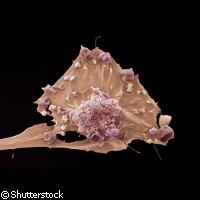Study sheds new light on tamoxifen resistance
Research by scientists in the UK and US reveals why some breast cancer patients respond well to tamoxifen while others develop resistance to the drug. Writing in the journal Nature, they explain that two molecules effectively fight it out for control of a key breast cancer gene that causes the breast cancer cells to divide. According to the researchers, while the protein PAX2 works to keep the gene switched off, thereby preventing the cells from dividing, another molecule, AIB-1, acts to activate the gene and so promotes the growth of the tumour. The scientists found that the ratio of PAX2 to AIB-1 in the tumour predicts the efficacy of tamoxifen therapy. 'Tamoxifen has been a huge success story, helping to prevent breast cancer from recurring for many women,' comments Professor Sir David Lane, chief scientist at Cancer Research UK, which supported the study. 'Understanding why it occasionally stops working is really important because it allows us to identify new targets for drug development and who will need such treatments.' Tamoxifen is designed to prevent breast cancer from coming back and it is typically given to patients for five years after they are first diagnosed with the disease. However, some people develop resistance to the drug, meaning their cancer is more likely to recur. In many women with breast cancer, the hormone oestrogen locks onto a receptor on the cancer cells and causes the cells to multiply. Tamoxifen blocks this receptor and so stops the oestrogen from promoting uncontrolled cancer cell proliferation, but until now the exact mechanisms involved were a mystery. In this study, the scientists applied the latest in genomics technology to find out where the oestrogen receptor was interacting with the genome. 'We knew that women developed resistance to tamoxifen but previously our understanding of why this occurred could be compared with trying to fix a broken car without knowing how the engine worked,' explains the lead author of the study, Dr Jason Carroll of Cancer Research UK. 'Now we understand how all the engine parts operate and we can try to think about ways to make repairs.' The research revealed that tamoxifen uses a protein called PAX2 to switch off the breast cancer gene ERBB2. Patients taking tamoxifen who had higher levels of PAX2 in their tumour samples were found to have higher survival rates than patients with lower PAX2 levels. Meanwhile, drug-resistant tumours were found to have higher levels of another molecule called AIB-1. AIB-1 competes with PAX2 for control of the ERBB2 switch; however while PAX2 holds the switch in the off position, AIB-1 works to activate the gene, effectively switching it back on. Overall, the scientists found that the balance between PAX2 and AIB-1 dictates the level of ERBB2 activity and ultimately determines whether tamoxifen will be effective or not. Patients whose tumours were PAX2 positive and AIB-1 negative had the best prognosis of all, with a recurrence rate of just 5.8%. Although these results undoubtedly represent a major step forward in our understanding of breast cancer, further research will be needed before they can be transformed into a test that could be used in the clinic to predict a patient's likely response to tamoxifen.
Countries
United Kingdom, United States



